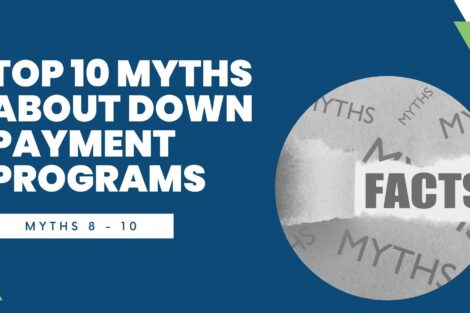
Final 3 Down Payment Program Myths Debunked


When it comes to a down payment on your home, are you aiming high or low? The down payment is the number one reason most buyers wait longer than they’d like to buy a home. In fact, many sidelined buyers have the income and qualifications to make the monthly mortgage payment, but lack the down payment.
But, there’s also a misperception about 20 percent down. In a NerdWallet study, 44 percent of Americans believe you need 20 percent or more to buy a home. The reality is that about 60 percent of homebuyers financed their purchase with a 6% or less down payment, according to the National Association of REALTORS®.
The fact is there are no cookie cutter mortgages — your home financing will be as unique as you. FHA is known for their low down payments for first-time homebuyers, but many conventional fixed rate loans offer lower than FHA’s 3.5% down.
What about zero down? VA loans for armed service members and qualified veterans provide a great value, including no down payment, relaxed credit requirements and no mortgage insurance. (Plus, down payment programs may help with closing costs and even an equity boost.)
Some lenders offer grants to buyers to overcome the down payment hurdle. But, according to guidelines from Fannie Mae and Freddie Mac, lenders can make contributions to a borrower’s down payment or closing costs only after the borrower has contributed a minimum 3% down payment.
“To meet that 3% threshold, the borrower can still come with funds from a relative, a government agency — such as grants from a housing finance agency — or from an employer housing program. That has not changed,” says Lisa Tibbitts, a spokeswoman for Freddie Mac.
Let’s take a look at the pros and cons of a smaller down payment.
You can buy a home sooner. With a lower down payment, you’re putting less down and not saving as long before you get in a home. It can help you secure a loan at today’s low rates and avoid any rent increases that may be on the horizon.
You’ll have more reserve funds on hand. When you buy a home, there are many other related costs, including home repairs and improvements. With a smaller down payment, you’ll avoid being “house poor” as soon as you leave the closing table and can enjoy using some of your hard earned dollars to make the home your own.
Down payment programs can help. Don’t overlook down payment programs as part of your home financing. These programs can help boost your down payment savings or even provide a tax credit for the life of the loan. Some programs provide affordable first mortgages with a very low down payment. Find out what programs may be in your area.
Your monthly payment will be larger. When you put less down, your home loan — and monthly payment — will be larger. Work with your lender to ensure you are comfortable with the monthly payment.
You may be required to pay mortgage insurance premiums. Some down payment programs may waive mortgage insurance (MI), but in most cases if your down payment is below 20 percent, you’ll be required to get MI — it helps manage risk for your lender and protect them if you fail to repay the mortgage. It’s important to note that with a conventional, fixed rate loan and borrower paid MI, you can cancel your mortgage insurance when you reach 20% equity in your home. With an FHA loan, you must continue to pay MI for the life of the loan.
Could hurt in a competitive market. Unfortunately, some sellers see smaller down payments as a negative, although it’s not necessarily true. In fact, the seller may actually earn less on the home from an all cash buyer with a lower offer. Plus, some down payment programs will fund your closing costs — something you won’t have to negotiate with the seller. Put the seller at ease by getting your financing set up early and documenting it in a letter accompanying your offer.
The bottom line? The right down payment for you depends on your situation. Weigh the overall pros and cons of a low down payment and talk with your lender about what is the best fit for you.
